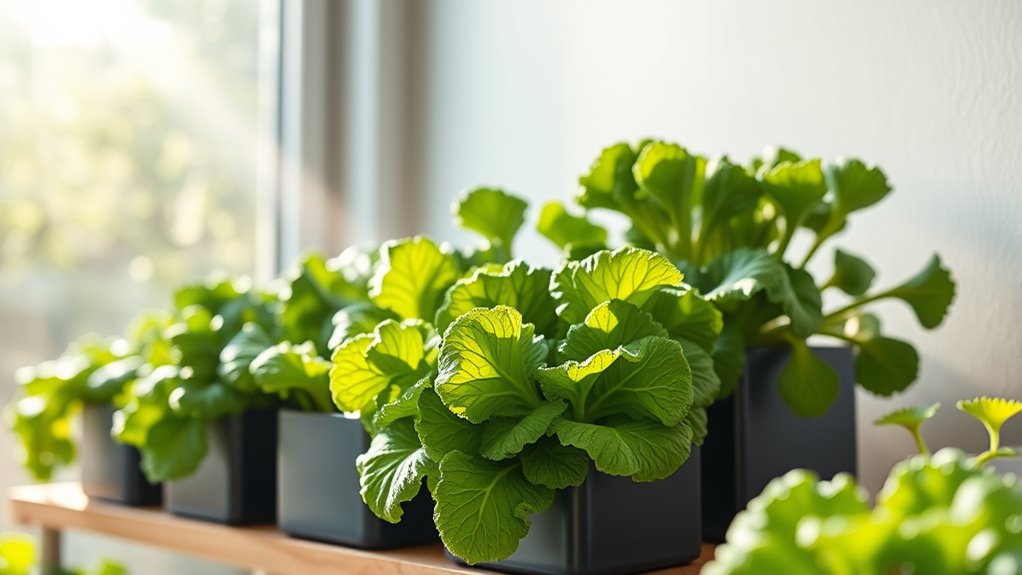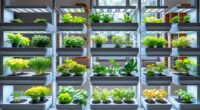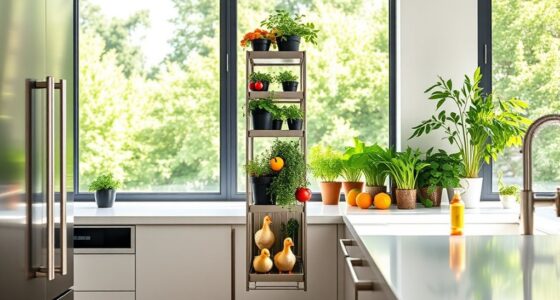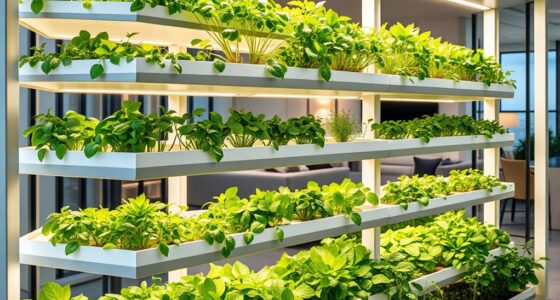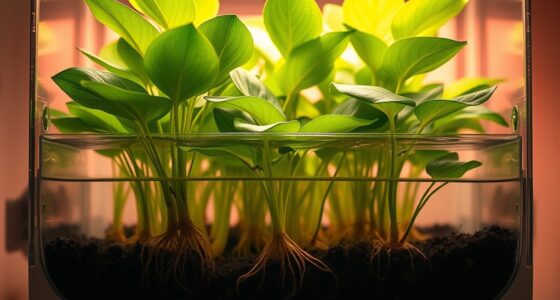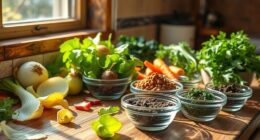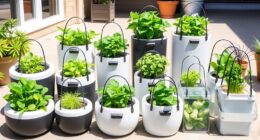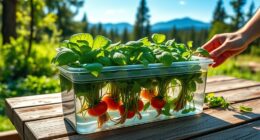To keep greens fresh and thriving indoors year-round, focus on creating the right environment with quality, organic potting mixes that support healthy roots. Manage soil moisture carefully and incorporate compost to boost nutrients. Prevent pests by maintaining cleanliness and controlling humidity, while using organic controls like neem oil. Monitor environmental conditions with smart technology to optimize temperature and humidity. Keep these strategies in mind, and you’ll discover even more ways to make sure your greens stay vibrant all year long.
Key Takeaways
- Use high-quality, nutrient-rich potting mixes optimized for indoor soil health and root development.
- Maintain proper watering routines to prevent overwatering and root rot, ensuring consistent soil moisture.
- Control humidity and airflow with environmental monitoring to reduce pest attraction and promote healthy growth.
- Regularly inspect plants and use organic pest control methods to prevent infestations and maintain freshness.
- Incorporate organic amendments like compost to boost soil vitality and support year-round green growth.
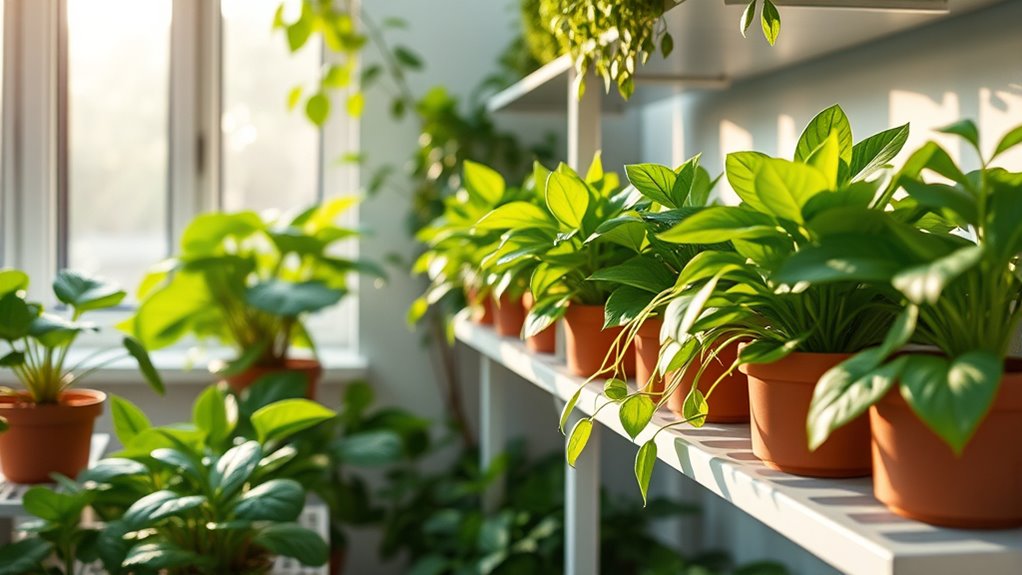
Growing greens indoors all year long is easier than you might think, thanks to modern indoor gardening techniques. The key is creating the right environment that promotes healthy growth while minimizing issues like pests and poor soil quality. To start, focus on soil health, which is fundamental for lush, nutritious greens. Use a high-quality potting mix specifically designed for indoor gardening. These mixes typically contain the right balance of nutrients, organic matter, and aeration to support root development. Avoid garden soil; it often harbors pests and diseases that can quickly spread indoors. Regularly check your soil’s moisture level and avoid overwatering, which can lead to root rot and other problems. Incorporating compost or organic amendments can boost soil vitality, ensuring your greens get the nutrients they need to thrive year-round. Maintaining proper soil health is also supported by modern AI-driven security systems that monitor environmental conditions and alert you to issues before they become serious.
Pest management is another essential aspect of successful indoor gardening. Unlike outdoor gardens, where pests come and go naturally, indoor environments can make pest infestations more noticeable and damaging. To prevent this, start with clean containers and tools, and inspect new plants carefully before introducing them to your space. Keep humidity levels controlled, as excessive moisture can attract pests like fungus gnats or aphids. If pests do appear, address them promptly using organic methods such as neem oil, insecticidal soaps, or natural predators like ladybugs. Maintaining good airflow around your plants also helps reduce the likelihood of pest problems, as stagnant air encourages pest and disease development.
Frequently Asked Questions
What Are the Best LED Lights for Indoor Greens?
When choosing LED lights for your indoor greens, you want options with the right LED spectrum and light intensity. Look for full-spectrum LEDs that mimic natural sunlight, promoting healthy growth. Guarantee the light provides sufficient intensity, especially during the early stages of growth. Adjustable brightness settings are a bonus, letting you tailor light levels as your plants develop. Ultimately, the best LEDs help your greens thrive year-round with consistent, quality light.
How Often Should I Water My Indoor Greens?
Ever wonder how often you should water your indoor greens? Your watering schedule depends on moisture levels—check the soil regularly, and water when the top inch feels dry. Usually, once a week works, but it varies with temperature and humidity. Remember, overwatering can drown roots, so make certain proper drainage. Keep an eye on your plants to maintain ideal moisture levels, and they’ll thrive indoors year-round.
Can I Grow Greens Without Soil Indoors?
Yes, you can grow greens indoors without soil using hydroponic systems, which are excellent soil alternatives. These systems use nutrient-rich water solutions to nourish your plants directly, allowing faster growth and fewer pests. You simply set up the system, provide light, and monitor water levels. Growing greens this way saves space, reduces mess, and is perfect for indoor environments, making year-round gardening easy and efficient.
What Pests Commonly Affect Indoor Greens?
You’re wondering about pests that often affect indoor greens. Common pests include aphids, spider mites, and whiteflies. To keep your greens healthy, practice pest identification regularly and act quickly when you spot trouble. Use organic pest control methods like neem oil or insecticidal soap to avoid harsh chemicals. Staying vigilant and maintaining good airflow helps prevent infestations, ensuring your indoor greens stay fresh and vibrant all year round.
How Do I Prevent Mold on Indoor Plants?
To prevent mold on your indoor plants, focus on mold prevention by maintaining proper humidity control. Avoid overwatering and ensure good air circulation around your plants. Use a dehumidifier if needed, and keep the environment dry and well-ventilated. Regularly check for excess moisture or decaying leaves, and remove any moldy spots immediately. These steps help keep your plants healthy and mold-free, promoting lush, vibrant growth indoors.
Conclusion
Imagine your indoor greens as a secret garden, quietly thriving under your care year-round. Just like a small seed can grow into a lush plant with the right attention, your dedication transforms your space into a vibrant oasis. With consistent watering, proper lighting, and love, you’ll enjoy fresh greens no matter the season—turning any corner of your home into a personal farm. Keep nurturing your indoor garden, and watch it flourish like a well-kept secret waiting to be revealed.
